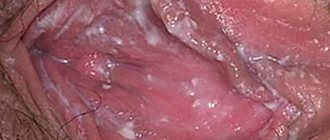Pain in the ovaries — For clarification about the causes and treatment of this symptom, women often turn to the gynecologists of our Leib Medic medical center, which is conveniently accessible for treatment from many districts of Moscow. Treatment of pain in the ovaries is one of the specialized areas of our medical center, where experienced responsible doctors of various specialties work, including gynecologists. The cause of pain in the ovaries can be the following diseases, pathologies and conditions that require professional treatment or observation:
- ovarian apoplexy
- polycystic ovary syndrome
- ovarian cyst
- the presence of microbial lesions of the ovaries
- ovarian cancer
- natural causes of ovarian pain
- pain in the ovaries during abortion
- pain in the ovaries when taking birth control pills
- pain in the ovaries during artificial insemination
The female reproductive organ system is represented by the uterus and ovaries. The ability to produce offspring and the health of the unborn child depend on the condition of the ovaries. However, more than 70% of women, especially in cities, suffer from various problems of the reproductive system, including the ovaries. Much of the reason for this is the lifestyle that modern ladies adhere to and especially their clothing. After all, even in severe frosts, women prefer to wear miniskirts instead of warm clothes.
Why do my ovaries hurt, left or right?
Typically, pain in the ovarian area is cramping and stabbing in nature. However, based on these signs, it is impossible to accurately determine that it is the ovaries that are hurting. After all, inflammation of appendicitis, kidney disease and digestive system have the same expression. Therefore, you should not diagnose yourself; you can see a gynecologist at our medical center in Moscow.
In some cases, the pain may be periodic. In this case, the pain manifests itself either in the lower abdomen, then in the kidney area or in the pubic area. At times you may experience leg cramps. Pain in the left ovary is rare and mainly indicates a harmful external influence. If there is pain in the left ovary, most likely it is due to the medications you are taking.
Pain in this area indicates problems with the reproductive system or hormonal phenomena. Both types of illness can lead to complications, so you should not delay the examination. Only an experienced doctor will be able to accurately determine the disease and say exactly why the ovaries hurt.
Treatment of ovarian apoplexy at Life Medic
Ovarian apoplexy is one of the most serious problems. In this case, hemorrhage occurs in the ovary, which poses a threat to the normal functioning of this organ. To understand how this happens, it is necessary to consider the menstrual process in a woman’s body:
1. When an egg matures in a follicle, it must receive sperm.
2. This does not happen and due to the death of the egg, menstruation occurs.
3. The blood of the dead egg filling the follicles is removed from the body.
So at this time, these organs are especially tense, as they are filled with blood, and the risk of damage to blood vessels also increases. When the walls of the ovary cannot withstand it, the blood entering it from the artery spills inside.
Causes of ovarian apoplexy
In general, the right pair is more often susceptible to apoplexy, since it is larger and more blood circulates in it than in the left. Therefore, the right ovary hurts more often. Blood enters the right organ directly from the aorta, and the left one through the blood vessels of the kidney. This also causes increased pressure and tension in the right organ. So, if for some reason the right ovary hurts, then the reason is most likely apoplexy.
Ovarian apoplexy most often occurs in teenage girls and young women. In many ways, it is this group that is at risk, since the reproductive organs most actively perform their function in them. In very rare cases, apoplexy can result from mechanical damage. Other causes of apoplexy
In addition to natural processes, hemorrhage can be caused by:
- overly active sex
- improperly performed gynecological procedure
- excessive stress on muscles
These are all mechanical factors. However, there are also pathogenic factors:
- pathology of the uterus;
- tumors;
- varicose veins;
- improper healing after surgery or injury;
- ovarian inflammation
So pain is a symptom not only of disorders in these organs themselves.
Symptoms of ovarian apoplexy
The main sign of apoplexy in a woman’s body is acute pain in the ovary or lower abdomen, which aches. And usually the right ovary hurts. However, the disease may be accompanied by other signs:
- vomit;
- dry mouth;
- tachycardia;
- stickiness of sweat;
- hypotension;
- pale skin color;
- temperature increase.
Usually, additional symptoms indicate that the accumulation of blood has reached its critical level and an attack of pain may soon occur. When the right or left ovary is pulled, it is necessary to urgently consult a doctor, otherwise complications are possible.
Treatment of polycystic ovary syndrome at Leib Medic
Polycystic ovary syndrome is one of the main diseases leading to infertility. Cystosis develops very slowly and it is rarely possible to detect it in the initial stages. It is usually diagnosed accidentally, during the next examination. Tingling in the left or right ovary can be a symptom of a similar disease. However, polycystic disease can be expressed by tingling in the right ovary. The disease occurs due to improper formation of the egg. Sometimes due to pathologies of the ovary itself. In both cases, it is difficult for the egg to leave the organ and over time the channels begin to accumulate tissue of residual eggs and polycystic disease develops. Also, a large number of underdeveloped eggs accumulate in the organ itself. Polycystic ovary syndrome mainly occurs in women under 35 years of age. It is especially dangerous for teenagers who are just beginning to menstruate. The presence of cystosis, in addition to periodic pain, causes disruption of the menstrual cycle. So polycystic disease has a direct effect on hormonal functions. This can disrupt hormonal processes, which usually leads to cardiovascular diseases, diabetes, etc.
Causes of polycystic ovary syndrome
The exact reasons for the occurrence of polycystic ovary syndrome have not yet been identified. All patients had the following pathologies, which presumably lead to the development of this disease:
- endocrine system imbalance;
- insulin oversaturation;
- chronic inflammation;
- obesity;
- heredity.
Any of these pathologies can lead to the formation of ovarian cysts.
Symptoms of polycystic ovary syndrome
Doctors identify the following symptoms of cystic disease:
- abnormal menstruation;
- hypertrachia (excessive hairiness);
- skin problems;
- pulling sensation in the ovary area;
- excessive weight.
All these signs are associated with pain that occurs in the lower abdomen.
Complications after inflammation of the appendages
Inflammation of the appendages can lead to many complications associated with suppuration and the subsequent transition of the disease process to the peritoneum, covering the pelvis and abdomen. There is a risk of developing a condition of peritonitis (local or diffuse).
The inflamed structures, together with neighboring organs, form a so-called inflammatory tumor, which should be operated on after acute symptoms have resolved.
Other complications of adnexitis:
- fallopian tube abscess;
- ovarian abscess;
- ovarian-fallopian abscess;
- Douglas cavity abscess;
- rupture of abscesses and formation of fistulas;
- inflammation of the uterus;
- fallopian tube cyst;
- fallopian tube hematoma;
- adhesions in the pelvis;
- infertility due to inflammation of the fallopian tubes, which makes transporting the egg impossible, as adhesions form, which obstruct the tube.
A complication of adnexitis during pregnancy is ectopic pregnancy in the fallopian tubes - a fertilized egg cannot enter the uterine cavity due to post-inflammatory changes in the mucous membrane of the fallopian tube and implantation of the embryo in an unsuitable place.
Microbes in the ovaries
Of course, the presence and large accumulation of harmful microorganisms in the organs of the reproductive system leads to inflammatory processes and gives rise to pain in the ovary. When the number of such microbes reaches a critical level, thrush and candidiasis develop.
At the same time, thrush indicates a decrease in immunity in a woman’s body, when candidiasis, like a fungal disease, develops as a result of:
- excess sugar in a woman’s body;
- hormonal surges;
- any infectious disease;
- excess antibiotics;
- poor hygiene of the intimate area.
For both thrush and candidiasis, the symptoms are almost identical and are expressed:
- in the presence of unpleasant odors;
- presence of itching;
- pain when urinating;
- inflammation of the genital organs;
- pulls the ovary;
- pain during sexual intercourse.
This disease can be cured with the help of anti-inflammatory and antibacterial agents.
Treatment
Severe forms are treated in a hospital. Therapy is conservative, long-term. The course is selected individually. The range of measures taken usually includes:
- drug therapy - antibiotics, anti-inflammatory drugs, immunomodulators, vitamins, eubiotics;
- hot douching, ichthyol suppositories, Longidaza;
- physiotherapy – mud, diathermy, ultraviolet irradiation, inductothermy, massage.
Indications for surgery include pain, purulent inflammation, adhesions, and peritonitis.
Ovarian cyst - treatment in Moscow, Life Medic clinic
Ovarian cyst is a common disease that occurs in women, and specialists from the Moscow medical center Life Medic assist patients in treating ovarian cysts using specialized techniques. Unlike polycystic disease, when tissue of underdeveloped eggs accumulates in this organ, when a cyst forms under the ovary, usually the right one, the cortical ovary swells pouch. This happens due to the accumulation of yellow cell fluid in it, which is actively released during the post-ovulation period. However, yellow cells are not always to blame. So:
- a cyst may be an accumulation of dead ovarian tissue, leading to the development of cancer;
- a thick-walled cyst usually results from epidermal deposition;
- a capillary cyst is usually a manifestation of natural organic processes;
- a multi-chamber cyst is a consequence of the accumulation of various tissues, including fluids, which also leads to cancer.
The exact reasons for the formation of cysts in women have not yet been established. Many experts argue that the main causes may be hormonal pathologies. In addition, there have been cases where the formation of a cyst was accompanied by chronic inflammatory processes. Usually, it is not possible to detect the presence of a cyst by observing external manifestations, because the formation of a cyst does not have any symptoms. Most cases are detected during a routine examination by a gynecologist. With excessive physical exertion or very intense sexual intercourse, pain may be felt in the right ovary.
Inflammation of the appendages - symptoms
Symptoms of adnexitis depend on the type of disease. Most often they appear immediately after obstetric and gynecological procedures or uterine bleeding. The condition of acute adnexitis is characterized by high fever and malaise.
The most annoying symptom is pain in the lower abdomen. It is acute in nature, and its severity can be so significant that some patients cannot touch the sore spot. Sometimes symptoms from other organs occur.
During inflammation of the pelvic organs, an abscess develops, occupying the Douglas cavity. Swelling and swelling can put pressure on the rectum, causing diarrhea, constipation, and even intestinal obstruction. The mucous membrane of the uterine cavity, affected by the inflammatory process, gives other symptoms - blood or pus coming out of the cervical canal.
If the inflammatory process is not sufficiently treated, subacute or chronic adnexitis may develop. Then the symptoms will be less turbulent. Pain in the lower abdomen occurs to a lesser extent - in chronic conditions it is nagging, pain more often appears during physical activity and sexual intercourse. Body temperature is less high.
Ovarian cancer
Ovarian cancer is detected in older women up to 70 years of age. In more than thirty percent of cases it leads to death. Basically, such malignant formations in the reproductive system are divided into the following groups:
- initial, when a cancerous tumor arose in the ovary itself for no apparent reason;
- secondary, when cancer causes the death of benign cells;
- Metastatic cancer appears due to cancer cells entering the ovaries from another organ through the blood.
The causes of cancer cells in the body are still unknown. Doctors attribute most cases to age and heredity. In addition, hormonal processes are of no small importance.
The signs of a malignant tumor are quite obvious. So in cancer there are:
- a feeling of discomfort reminiscent of a digestive tract disorder;
- persistent feeling of fatigue;
- constant feeling of the presence of a foreign object in the abdomen.
The growth of the tumor causes pain in the left ovary or in the right and difficulty urinating. In addition to a decrease in the amount of menstrual flow, the woman is attacked by apathy and depression does not leave her.
Natural causes of ovarian pain
It is not necessary that a certain pathology be present in the body if there is pain in the lower abdomen. During the week before menstruation, a feeling of discomfort in most women is considered normal. At the same time, the ovary hurts before menstruation. This is a manifestation of natural physiological processes. In addition, the ovary hurts during menstruation for the same reasons.
Another category of natural causes of pain in the lower abdomen is associated with the natural expansion of the uterus and the accumulation of yellow cells due to a woman’s pregnancy. Typically, abdominal pain is felt in the first trimester. But they are not frequent or regular, but appear in isolated cases. However, during pregnancy, the fact that the ovary hurts on the right or left may be the result of some other reasons that will lead to complications and harm the woman’s body and the fetus. These include:
- inflammatory processes;
- infectious diseases;
The most dangerous form of inflammatory processes is inflammation of the ovaries themselves. This disrupts the formation of yellow bodies, which leads to underdevelopment of the fetus at the initial stage of pregnancy. In this case, the left or right ovary colitises, since the inflammation primarily affects it.
Causes of endometriosis
Previously, it was generally accepted that endometriosis most often develops in women after 40 years of age, but in recent decades this disease has become “younger.” There is no consensus on the reasons for the development of this pathology. The following theories are considered the most reliable:
- genetic predisposition (can be inherited);
- retrograde menstruation (blood enters the pelvic cavity, so endometrial cells find themselves outside the uterine cavity, attach to surrounding tissues and grow);
- metaplasia or cell degeneration (peritoneal cells transform into endometrial cells of the uterus under the influence of hormonal and immune factors);
- hormonal disorders (imbalance of sex hormones);
- immune failure (the body does not remove endometrial cells brought into the abdominal cavity).
Predisposing factors also include infectious diseases, hormonal disorders, uterine fibroids, inflammatory diseases of the reproductive organs, operations on them, abortion, curettage, pathological childbirth, iron deficiency, poor ecology, liver diseases.
Abortion as a cause of pain in the ovaries
An incorrectly performed abortion procedure can cause pain in the ovaries due to infections or damage to the ovaries when the fetus is removed. Both ovaries can hurt at the same time. This is one of the few reasons why the left ovary hurts, since in most cases the pain radiates to the right. Typically, such symptoms appear exclusively in the first week after the procedure. In addition, the abortion procedure can lead to disruption of menstrual processes and the functioning of endocrine organs. But most of all, the organs of the woman’s reproductive system suffer from this procedure, mechanically or otherwise. Therefore, after an abortion, the risk of infertility is very high.
Unpleasant sensations due to endocrine pathologies
In some cases, the ovary is pulled due to hormonal disorders. Since the gonads are endocrine organs, their functioning depends on the work of the pituitary gland. Hormonal imbalances can lead to a decrease in estrogen production in the ovaries. This, in turn, is fraught with infertility and the development of other pathological conditions.
Excessive release of female sex hormones is also harmful to the body. Hyperestrogenism is one of the main predisposing factors in the development of oncological processes of the cervix, endometrium and ovaries. In addition, hormonal imbalance can lead to breast cancer.
Pain in the ovaries when taking birth control pills
More than half of the world's women prefer to avoid unwanted pregnancy by using oral contraceptives. However, most of them have no idea what exactly the effect of such pills on the body entails. Thus, most of these drugs accelerate or inhibit hormonal processes. This is mainly a consequence of the need to increase the production of estrogen, which activates the menstrual process and prevents pregnancy. If, along with the right one, the left ovary hurts, then the reasons are precisely this effect on the uterus. Typically, ovarian colitis occurs in 90% of such patients in the first three months after starting medication. This is normal if, along with the right one, the left ovary colitises. However, if the pain does not go away longer than this, then perhaps due to a hormonal imbalance, a cyst or something else has formed in the ovary.
Diagnosis of endometriosis
Anamnesis and general gynecological examination usually only suggest the presence of pathology.
Endometriosis is often discovered incidentally during other diagnostic or surgical procedures. If this pathology is suspected, colposcopy and cervicoscopy (examination of the cervix), ultrasound of the pelvic organs, hysterosalpingography (examination of the patency of the fallopian tubes), MRI, CT and spiral CT of the pelvic organs (can identify uneven contours, increased tissue density, nodules, cysts) are performed ), cystoscopy (if damage to the bladder wall is suspected).
Laboratory tests for endometriosis include a general blood test (to identify inflammatory reactions) and determination of the level of sex hormones (follicle-stimulating, luteinizing, testosterone), as well as the level of the tumor marker CA 125, which indicates the presence of pathological processes in the ovaries.
If necessary, diagnostic laparoscopy is performed - small incisions on the anterior abdominal wall for visual examination of the abdominal cavity and pelvic area.
What to do if your ovaries hurt?
So, what to do if your ovaries hurt. When pain occurs in the pelvic area, rest is necessary. It is necessary to limit yourself from stress, both physical and emotional. It is also worth reconsidering your diet; you may need to go on a diet. In your diet, you should limit yourself from salty and excessively fatty foods. It is recommended to consume more dairy products, fresh fruits and vegetables.
Folk remedies for such a symptom are absolutely not advisable. But after consulting a doctor, you can take mud baths and salt baths. Medicinal decoctions should also be taken in consultation with your gynecologist. An experienced doctor will also tell you what to do if your ovaries hurt.
If acute pain occurs, you must call an ambulance. You should not try to figure out the reasons on your own, even if this has been observed and successfully eliminated before.
The role of the ovaries in the female body
In size, they are no larger than a peach pit. When there are no pathologies in the body, the left one is always somewhat smaller in size compared to the right one. This organ is a composite organ and is represented by a cortex and connective tissue. Disruption of these components causes general malaise and problems with the functioning of other organs of the female body.
Reproductive function of the ovaries
This paired organ plays a major role in the process of reproduction. After all, they are the ones who produce eggs, which, after fertilization by male sperm, give rise to the birth of a new embryo. They are located on both sides of the uterus, in the pelvic region. Immediately after fertilization, the ovulation process stops and the ovaries begin to produce a temporary protective layer for the future fetus - yellow bodies. However, this layer disappears after the formation of the uterine placenta. Usually replacement occurs after the first 20 weeks of pregnancy.









